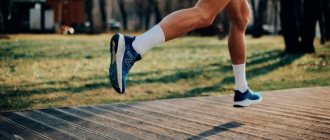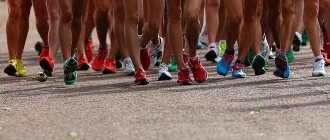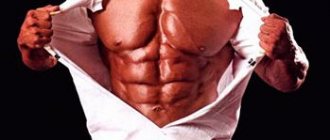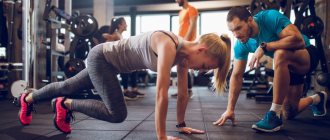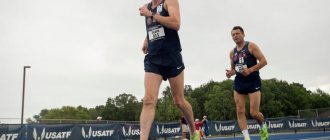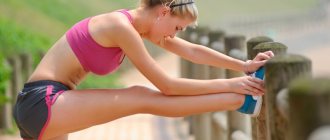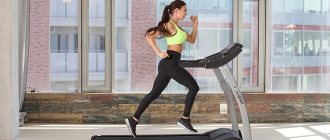But first of all, you need to know about such an important concept as “target heart rate” (THR), since this simulator involves quite significant cardio loads.
CSR is 60-90% of the maximum heart rate. The target heart rate is calculated using two formulas: WCH = 220 - age, or more accurate: 205.8 - (0.685 x age). Of course, only a doctor can accurately estimate the target heart rate. It is important to know this indicator and try not to exceed it while jogging.
The process of losing excess weight using a treadmill can be represented in several stages:
Stage 1
The first thing to do is to get your body used to jogging, so you should start with light training, gradually increasing the intensity, frequency and distance. Trainers and doctors advise that at first you just walk or run along the path relatively slowly. Despite tempting stories that you can burn 600 or more calories in an hour of running, you should start jogging in small doses. The first couple of weeks you should exercise from 10 to 30 minutes, about two to three times a week. The main thing is to feel that the muscles and body are working, but not to the point of exhaustion, otherwise there is a risk of injury.
Stage 2
A couple of weeks after the first workout, once a week you can begin to slightly raise the inclination of the treadmill, by about 1.5-2 degrees. It is important, at the same time, to try to adhere to the usual rhythm of running, and not to give yourself any relief, and also not to reduce the running time. But, at first, beginners should do incline training no more than once a week.
Stage 3
Once a week you need to approximately double the distance. The running speed, of course, can be reduced, the main thing is to run twice the distance.
Stage 4
Next week you can increase another component - speed. For those who train at a simple pace, it is recommended to add a short jog; for those who run at a moderate speed, you can speed up a little. The main thing is not to overdo it and stick to your target heart rate.
Stage 5
Calorie monitoring. It is necessary to monitor the level of calories consumed. It is advisable to do this from the first training session. Physical exercise gives an excellent effect, but if you do not pay attention to the food you eat, then you can wait a very long time for the results of your training. You should cut back on your calorie intake a little. Let's say, if a person consumed about 1700 calories daily, then they should be limited to 1500-1400. It is best to consult a doctor to find out your own individual calorie intake. The main thing is that the body continues to receive enough nutrients. It would be a good idea to create a food diary to clearly monitor your own nutrition until the new diet becomes a habit.
Prevent heart and vascular diseases
In 2016, scientists from the Lawrence Berkeley National Laboratory in California found that walking is more effective in preventing heart disease than running. Researchers compared the performance of runners from 18 to 80 years old and those who prefer regular walks at a brisk pace. It turned out that walking reduces the risk of cardiovascular disease by 9%, and running by 4.5%. At the same time, the load on the joints when walking is lower, which is important for older people.
Photo: istockphoto.com
Active walks in the fresh air activate blood flow, strengthen the heart and bones, tone muscles, improve sleep and lung function. In addition, they help relieve tension and fight stress.
Nordic walking: how to use poles to restore lung function and boost immunity
To achieve better results, you need to walk for 30-60 minutes every day. Just do it. A leisurely walk is not suitable as a workout if you want to increase endurance or burn calories. The step should be active, warming, so that the skin is covered with a light sweat. The speed can be increased gradually. If shortness of breath appears, it is better to slow down the pace. The optimal distance for a walk is 6-10 kilometers.
Exercises for weight loss on a treadmill
Each workout should begin with a warm-up and end with a cool-down. This should not be neglected. A sudden start has a negative impact on blood vessels and joints, so at least 2 minutes should be devoted to warming up. You shouldn't stop training abruptly either. A smooth “cooling down” allows the muscles to relax and the pulse to return to normal.
Warm-up and cool-down involve a gradual decrease in running speed. Before starting a workout, it is best to walk a little, then start jogging, and after that start at your usual speed. The cool-down does the same thing, only in reverse order. Those who only do treadmill walking can do a 5-minute exercise to warm up the body. It includes smooth head tilts, arm rotations, body bends forward, backward, to the sides and squats.
A standard weight loss program for beginners includes:
- Warm-up 2 minutes (Speed during warm-up - maximum 8 km/h, inclination angle 0%);
- Running at a speed of 10 km/h with an incline angle of 0% – 3 minutes;
- Running at a speed of 10.5 km/h with an incline angle of 1.5% - 3 minutes;
- Running at a speed of 11 km/h with an incline angle of 1.5% - 2 minutes;
- Running at a speed of 11.5 - 12 km/h with an inclination angle of 1.5% - 2 minutes;
- Jogging – 4 minutes;
- Hitch.
These exercises need to be repeated once or twice (warm-up and cool-down are done once).
This is just one of the few programs. Everyone can choose a comfortable rhythm and intensity for running on a treadmill (read about interval training on a treadmill).
Virtually no contraindications
Running perfectly strengthens muscles and increases endurance, but also has a number of contraindications:
- excess weight (due to high load on the spine and knee joints);
- cardiovascular diseases (hypertension, coronary heart disease, heart failure and others);
- joint problems (osteochondrosis, intervertebral hernia, arthritis);
- phlebeurysm.
Walking has almost no restrictions. You can start with it to tone your muscles before running training. It is a must for those who lead a sedentary lifestyle. This is the optimal load even for people suffering from diabetes and asthma.
Run for fun. How to make the first start comfortable for a beginner
Exercise regimen for losing weight on a treadmill
For newbies:
- Duration: 10-20 minutes;
- How often: 3-4 times a week;
- How long: 3-4 weeks;
- Target heart rate during warm-up and cool-down: 55-65% of maximum heart rate;
- Target heart rate during exercise: 65-75% of your maximum heart rate.
For advanced runners:
- Duration: 40 minutes (minimum);
- How often: 4-5 times a week;
- How long: 3-4 weeks (can last longer if desired);
- Target heart rate during warm-up and cool-down: 55% - 65% of maximum heart rate;
- Target heart rate during exercise: 80% - 90% of your maximum heart rate.
Correct walking: fast or slow?
There are several studies that draw a parallel between walking speed and personality traits. For example, it is believed that a fast gait is characteristic of people with a tendency toward perfectionism and high self-esteem. Scientists believe that such impetuous people are characterized by introversion and difficulties in communicating with the opposite sex.
However, one should not take these data seriously: all of them did not have a large number of participants. With such a small sample, it is difficult to talk about the reliability of the study.
A fast pace is more beneficial than a slow one
Doctors have also found that a person’s slow walking speed is directly related to the deterioration of organ function and rapid aging. But here it’s more about the inverse relationship: the body influences a person’s walking speed, and not vice versa.
Last summer, Australian scientists conducted an experiment. They found that brisk walking reduces mortality by 20%. More than 50 thousand people over 30 years old took part in the study.
The experiment lasted 2 weeks. According to its results, it turned out that slow walking slightly reduced the risk of premature death from all known causes. The average speed of a person increased the likelihood of living longer by 20%, and a fast step - by 24%. The most significant results were observed in subjects over 60 years of age: depending on step speed, the forecast for an increase in life expectancy reached 53%.
Don’t take the numbers for granted - check and adjust to your body’s comfort level
Sports and osteochondrosis: beneficial or harmful?
Osteochondrosis is a pathological lesion of the intervertebral tissues of the spine. As a result, the cartilage loses strength and elasticity, which can completely destroy it.
Causes of osteochondrosis: excess weight, bad habits, long stay in an uncomfortable or incorrect position, unexpected heavy physical activity, metabolic disorders, sedentary lifestyle, lack of magnesium, calcium and B vitamins in the body.
Many do not pay due attention to this disease, and, as a result, constant headaches, dizziness, pain in the chest, shoulders and arms. And with such symptoms you can’t really run. What do doctors advise?
Is it possible or not?
There are two opposing opinions of experts regarding running with osteochondrosis. Some argue that it is impossible to run, because when a person runs, the body periodically comes off and comes into contact with the ground. As a result, the spine affected by osteochondrosis cannot cope with shock absorption. But not only the spine, but also the joints of the legs are responsible for shock absorption. Therefore, if the disease is at an early stage, and the attending physician has approved the desire to play sports, you can run. This is what experts say - supporters of a healthy lifestyle. But even here everything is not so simple and there are some nuances.
Expert advice
- When running, the main thing is to correctly and evenly distribute your body weight. This requires that the entire foot touches the surface during landing.
- The position of the feet also plays an important role. To prevent the body from swaying from side to side, they must be placed strictly parallel to each other. Otherwise, the entire weight of the body will fall on the front of the foot.
- It is necessary to choose the optimal step length - not too long, but not too short. A sense of convenience and comfort plays a role here.
- The body must be kept straight and vertical. This will help protect the center of the spine from further destruction. While running, you can help yourself by waving your arms, keep your head straight, and try not to tilt down.
All these recommendations are given only for the first stage of osteochondrosis and only after consulting a doctor. In the second, third and fourth stages, running is strongly not recommended, so as not to worsen the patient’s condition and not provoke an exacerbation of the disease. Otherwise, running can lead to serious injuries and displacement of the vertebrae. While running, each step strains the tendons and muscles, the spine is stretched, and when landing it is compressed, putting a lot of pressure on the spine.
If, after everything you’ve read, you haven’t changed your mind about running, and are firmly convinced of the need for it, here are some tips.
Adviсe
- Jogging shoes should be chosen with soft, springy soles. The insole must be orthopedic.
- For running in nature, not a hard surface (asphalt, concrete) is more suitable, but a softer one - grass or just dirt. This will help reduce the load on the intervertebral discs.
- If jogging takes place in a gym or gym, it is better to do it on an electric treadmill rather than a mechanical one. The presence of an electric motor in it will significantly reduce the amount of effort of the runner.
- Immediately before running, you need to do a short warm-up, and the exercises themselves should be held in light mode.
- It is better to start your workout with walking and slowly move on to a leisurely run.
- It’s also better to finish your workout by walking, and then take a contrast shower.
As a result, we can say that the benefits of running with osteochondrosis are much less than the likelihood of harm.
If you have a great desire to lead a healthy lifestyle, doctors advise giving preference to more gentle activities. For example, swimming, yoga, Pilates, cycling, race walking. Author: K.M.N., Academician of the Russian Academy of Medical Sciences M.A. Bobyr
Fat burning rate
Running definitely burns calories faster and more intensely. If you have no contraindications or restrictions, you are physically fit enough and regularly exercise, then you should choose various jogging options to lose weight. If you prefer walking, remember that walking with periodic changes in speed is more effective, that is, alternating a slower pace with a period of acceleration. With this training regimen, calories are burned faster.
Article on the topic
It's all about the sticks. What are the benefits of Nordic walking?
Walking and running shoes
When choosing shoes for sports, you need to clearly understand what characteristics it should include. If we choose sneakers for walking and running, then we are lucky, since there is no big difference in the set of criteria in this case. Running shoes also work well for walking.
Features that sneakers must meet:
- Minimum shoe weight (optimally 300 grams);
- Thick sole made of special gel or foam;
- High heel for stability of the foot when moving.
These are the most important criteria that shoes for ground-based cycling sports must meet.
A consultant from a branded sports store will always help you choose the best option. Yes, shoes in such stores are much more expensive and cost on average 4,000-6,000 rubles, but the quality is much higher. And by quality we mean not only the period of wearing, but the comfort and quality of training. You can also make a profitable purchase if you follow the promotions that are periodically held by all well-known brands.
Features of walking
Each person moves at different speeds. It depends on the:
- His height and stride length;
- Age parameters;
- Physical condition;
- Time restrictions;
- Acceleration of the step;
- Topography of the area.
Typically, speed parameters are calculated taking into account:
- How many steps can a person take per minute at a certain load.
- Walking pace.
- The average length of a human step is 71 cm.
Now let’s look at specific generally accepted indicators using generally accepted measures of walking.
